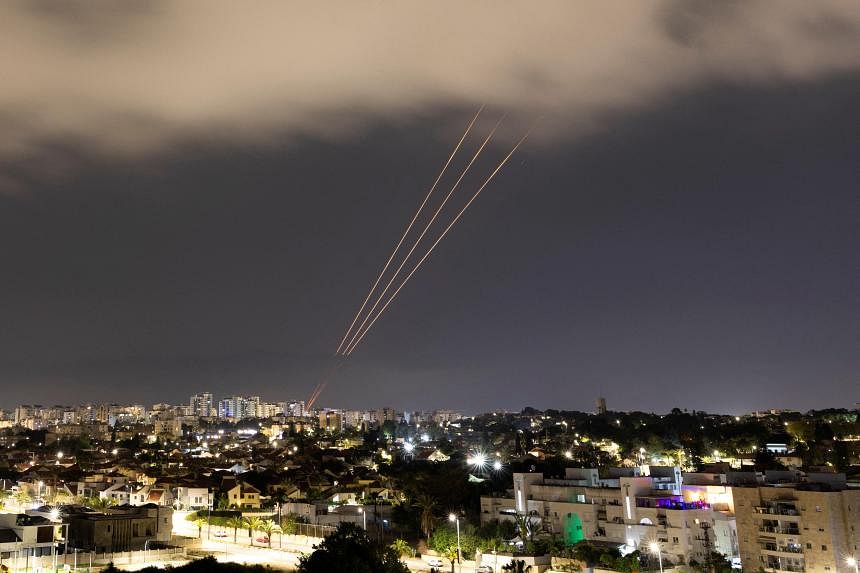NEW YORK – After days of uncertainty, Iran launched a major missile and drone attack on Israel, starting late in the night of April 13.
Over the past decade and a half, Israel has upgraded its air defences considerably, adding new systems for interceptions of ballistic missiles fired from as far away as 2,400km. That range includes Iran as well as Yemen, Syria and Iraq, where militant groups allied with Iran are based.
While these new systems have passed years of testing to become fully operational and have notched a few successful interceptions in the battlefield, they had not yet dealt with a large-scale attack before Iran’s offensive.
In the April 13 attack, Israel and its allies intercepted the “vast majority” of the 200 drones and missiles fired by Iran, most before they entered Israeli airspace, said military spokesman Daniel Hagari in a briefing. He said the only impacts were to a 10-year-old girl who was badly wounded and minor damage to an army base.
What air defences does Israel have?
The most active and well known of Israel’s air defences is the Iron Dome, which has intercepted thousands of rockets fired by Palestinian militants in Gaza since 2011. However, Iron Dome is designed for missiles and drones with a short range, from 4km to 70km, and is just one of the various advanced missile defence systems in place in Israel.
In 2017, Israel installed a medium-to-long-range interceptor known as David’s Sling, which was co-developed by Israel’s Rafael Defence Industries and the US-based Raytheon Technologies. David’s Sling is designed to detect and destroy ballistic and cruise missiles, as well as drones, at a reported range of up to 200km. That range covers Gaza as well as southern Lebanon, where the Iran-backed militant group Hezbollah is believed to have 150,000 missiles, some of them precision-guided.
Israel also possesses the advanced Arrow missile defence system, made up of Arrow 2 and Arrow 3. Developers have said the Arrow system can intercept missiles fired from up to 2,400km away and can do it above Earth’s atmosphere.
The Israeli military also announced in April that a mobile, maritime version of Iron Dome – known as C-Dome – was operational and had successfully knocked down a hostile drone launched by Yemen’s Houthi rebels, who are backed by Iran.
The military is also testing another system called Iron Beam, which uses lasers to intercept projectiles fired at close range at a lower expense than Iron Dome. Iron Beam is not expected to be operational before mid-2025.
How effective are these systems?
Iron Dome has intercepted 90 per cent of missiles heading toward populated areas, according to Israel’s military. However, because the other air defence systems were only more recently introduced, there was no significant data on their real-time effectiveness.
In recent years, the military said the few cases of real-time response in battle were successful. Arrow 3, which was jointly developed by Israel Aerospace Industries and Boeing Co, notched its first battlefield success in November 2023 when it shot down a missile fired by the Houthis towards southern Israel. David’s Sling knocked down Gaza rockets in fighting that erupted last May.
The army has acknowledged that its air defences, including Iron Dome, can be overwhelmed if a large number of projectiles is fired simultaneously. Small drones fired by Hezbollah and the Houthis have also been able to slip through Israel’s defences since last October.
That was when war broke out between Israel and the Iran-backed militant Palestinian group Hamas, prompting other groups supported by Iran to join in.
What have Israel’s allies helped defend against the attack from Iran?
A US defence official confirmed that its forces in the region shot down Iranian-launched drones targeting Israel. The British Defence Ministry confirmed it deployed Royal Air Force jets to intercept Iranian drones headed for Israel if necessary.
What led to the Iranian attack on Israel?
The war between Israel and Hamas, which is considered a terrorist organisation by the US and European Union, has aggravated the so-called shadow war between Israel and Iran.
Iran blamed Israel for an April 1 air strike on the country’s diplomatic buildings in the Syrian capital Damascus, and vowed to retaliate. The strike killed seven Iranian military personnel, including a top commander of the Islamic Revolutionary Guard Corps, Iran’s premier security force.
Have other countries have purchased the Israeli air defence systems?
The war in Ukraine and fears of Russian hostility have prompted some European nations to bolster their air defences, including with Israeli technologies.
Germany agreed to buy the Arrow 3 system for €4 billion (S$5.8 billion), in the biggest military export deal in Israeli history.
Finland bought the David’s Sling system late in 2023 for €317 million, according to Rafael. Ukraine has expressed interest in purchasing Iron Dome, but Israeli leaders have been reluctant to supply it over concerns that the closely held technology could fall into the hands of Iran, which is allied with Russia. BLOOMBERG

